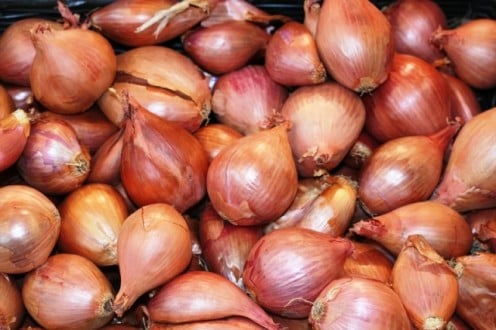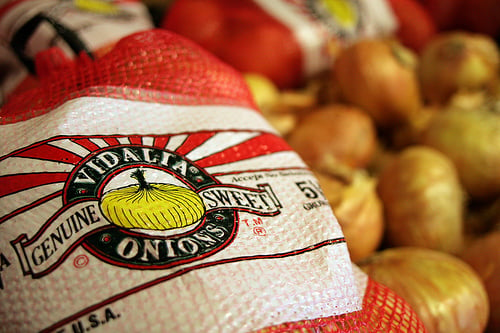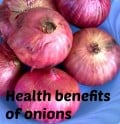Onions





It’s difficult to imagine cooking without onion. They are so necessary to cuisines around the world that the basic prep step in cooking many dishes calls for mirepoix, trinity, soffrito or something similar. These are simply the names of a mix of vegetables, including onion, the preparation of which is considered essential. The French have mirepoix, onion, celery and carrot sautéed in butter. The Italians soffrito, the same with the addition of garlic and sautéed in olive oil. The Cajun and Creole cuisines of Louisiana use the Trinity – onion, bell pepper and celery. But they all begin with onion.
Onions have been used by humans for millennia, although the dates of cultivation aren’t clear. Use dates to the Bronze Age – 5000 BC, and it’s certain that the builders of the Egyptian pyramids were fed onion. It was worshipped in Egypt as well, with the concentric growth pattern symbolizing eternal life. Ever since it’s been an integral foundation stone for the cuisines of most of the world’s cultures, spanning the globe fully. They have been valued as a food source not only for immediate or fresh use, but also because they are easily stored, and handle transport well. The Middle Ages saw Europeans using them as a type of currency, the Greeks used them for their athletes. Romans rubbed them on the body to firm up muscles. They arrived in the New World with Columbus, and throughout cultures and centuries they have been ingested or applied in various ways as a medicine.
Onion can be eaten in any number of ways, fresh, frozen, canned, preserved, smoked, and pickled among others. The flavor, depending on the particular cultivar, can range from sharp and pungent to sweet and truly mild. The onion is full of natural sugars, which caramelize beautifully, deepening and mellowing the flavors, and becoming complex with cooking. They even change in different ways depending on the type of cooking method – the stir fry with a hot fire in an iron wok results in a different profile then the long slow browning in butter over low heat.
Onions are not often eaten alone, but they are used extensively as an accompaniment, to bolster and highlight the flavors of other foods, or as a garnish. Mechanical manipulation before use runs the gamut as well, from a rough chop to the finest dice. The word onion is commonly used to refer to the standard garden or bulb onion, and these are all members of the genus Allium . Green onions, or scallions, are the same as yellow, white, Spanish or Vidalias, simply harvested earlier and eaten or used whole. When mature the tops are discarded – usually because they are bitter when older – and the bulb alone is utilized. Colors can vary significantly, from a pure white, to cream, to the reds and purples.




Onions have been promoted for centuries for the various beneficial effects on health, however, recent research has shown that there may be some truly advantageous elements to the onion. Non fat, and low in protein, they are loaded with Vitamin C and folate. They also contain significant amounts of anti-inflammatory and antioxidant properties. Studies have not yet born out regarding claims that the consumption on onion is tied to a reduced risk of diabetes or osteoporosis, but there have been some hints that they assist with a lower risk of head and neck cancers. In general, the sharper the taste, the higher the content of the pertinent nutrients – phenols and flavenoids – thought to have the most medicinal properties.
Check out the USDA’s Nutrition Facts page. Onions can be a good source of calcium, manganese, phosphorus, Vitamin B6 and potassium.
There are myriad folk methods for making sure that the preparation of onion doesn’t cause tears – cutting them under running water, having them well chilled or partially frozen, holding a toothpick in your mouth, leaving the root attached while cutting – but the cause of eye irritation is simple. The lacrimal glands are irritated by the release of chemicals present when the outer layer of onion is pierced and combined with others in the interior. Water will prevent some of this – washing away the offending chemicals and preventing the compounds from reaching the eyes and nose. However, it’s long been common knowledge in culinary circles that the most effective preventative of tears when cutting onions is a sharp knife. Speed and effective knife skills are your best friends. Keep your tools in top order and your knife work honed and you’ll be fine.
Onions are easy to find – even the smallest, most poorly stocked grocery has onions. At the least a yellow and white will be available. Larger stores will have more variety, with shallots and scallions available as well. In the spring look for Vidalia or Walla-Walla sweets, which don’t fare as well cooked as more pungent varieties, but are unbelievable eaten raw or barely sautéed. Farmer’s Markets often have more rare cultivars, including heirlooms which are making a comeback for more complex flavors. Try them all! Experiment with different varieties – none of them will be anything less than delicious, and you’ll discover the wonderful differences that can be found.
When purchasing onions, make sure the neck – the stem end – is tightly closed. You want a firm onion without soft spots – these indicate spoilage. You also want to avoid onions with dark places – this can indicate a black mold that will quickly spread and make the entire onion – or batch – nasty and inedible. Don’t purchase onions that have sprouted, and make sure that they are very dry. Moisture is an enemy to your onions.
Storage is also simple. But in small amounts – yellow and white onions are often sold in five pound bags, or buy just the two or three you’ll use within a few days. The most important elements to storage of onions is air circulation and temperature. Make sure you have a cool, but not cold, location – room temperature is fine for just a few days. Keep them dry, and make sure there is adequate air circulation. Don’t keep them in plastic bags – they’ll quickly go mushy and begin to rot. A wire basket is ideal. Don’t let them have direct sunlight and you’ll be golden!
If you wish to store a partial onion – you have a couple of choices. In all cases the onion should be tightly wrapped and placed in the refrigerator, and used within just a few days. Many cooks will chopped an entire onion, using only what they need for an immediate use, and store the rest for another day. You can also chop only part of the onion, leaving the root end attached, and chopping the rest as you need it, preserving a bit more of the moisture in the onion, and therefore more of it’s flavor.
- The Thrillbilly Gourmet
Combining classic technique with everyday food for spectacular results!








